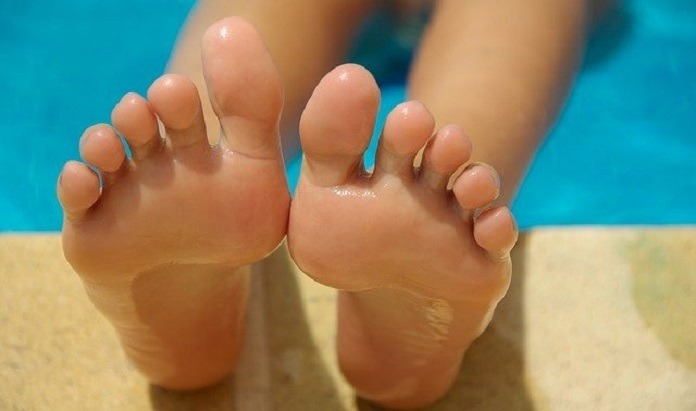Athlete’s foot, also known as tinea pedis, is an infection that typically occurs between the webs of toes, and may be accompanied by some painful blisters or bubbling.1 Athlete’s foot can also present itself on the soles, sides, and top of the feet.1 More aggressive forms have been associated with pain and foul odors.2
In almost one-third of cases, patients also have a related nail infection that requires medical attention.3
At the moment, a common method used in the clinic to diagnose athlete’s foot is through a skin lesion KOH exam.4 In this microscopic examination, the doctor will scrape the region of infected skin and dissolve it in chemicals that can help identify fungal infections.5
Who is at risk for athlete’s foot?
Athlete’s foot is a fungal infection that tends to occur in the feet of people who visit public swimming pools, as well as people who regularly wear athletic shoes and sports equipment.2 In fact, runners are almost at a risk almost twice as high as the general population.4 Studies have also revealed that people with weakened immune systems are at a higher risk of contracting the infection.4
Research has shown that about 70% of people will be infected with athlete’s foot at some point in their life.3 Due to the contagiousness of this disease, being a fungal infection, athlete’s foot can be considered a public health problem.3
Some common risk factors for developing athlete’s foot include excessive sweating, humid environments and sports.3 Overall, subjecting your feet to damp conditions for a long period of time may also lead to mixed infections with other bacteria.3
Studies demonstrate that athlete’s foot is more commonly developed in post-pubescent adolescents, relative to younger children.1 In fact, incidences of athlete’s foot increase with age and are more frequent in adults aged 31 to 60.3 When looking at the demographics, the risk appears to be higher for men.3
Treatments for athlete’s foot
It is often the case that patients are unaware of having athlete’s foot.3 However, if the infection becomes noticeable, there are accessible ways of treating it. Most commonly, people with athlete’s foot typically seek treatment due to itching and burning sensations in their foot.3 It is very important that professional athletes have prompt diagnosis and treatment for these types of infections, in order for them to continue training and competing at high performance.
Fortunately, this foot condition can be effectively treated using inexpensive creams – such as terbinafine or butenafine cream.1 The goal of these creams is to stop the growth of the fungal infection that causes athlete’s foot.2 However, complex forms of athlete’s foot that appear as plaques on the heels, soles, and sides of the feet tend to be more resistant to treatment.4
If a tinea pedis infection does not seem to be getting better, a medical practitioner may also recommend an oral treatment that is an anti-fungal agent.1 For example, oral terbinafine has been shown to have great efficacy.2 When undergoing oral treatment for athlete’s foot, it is also important for you to combine the treatment with other precautions. These include wearing anti-moisture socks on your infected foot, applying anti-fungal powders, and wearing proper footwear when entering gyms or public bathrooms.2 Lastly, if your athlete’s foot is a recurrent infection, you may benefit from drying between your toes after bathing, or wearing wider shoes.1
References
- Ely, J. W., Rosenfeld, S., & Stone, M. S. (2014). Diagnosis and Management of Tinea Infections. American Family Physician, 90(10), 702–710. www.aafp.org/afp.
- Flint, W. W., & Cain, J. D. (2014). Nail and Skin Disorders of the Foot. Medical Clinics of NA, 98, 213–225. https://doi.org/10.1016/j.mcna.2013.11.002
- Ilkit, M., & Durdu, M. (2015). Tinea pedis: The etiology and global epidemiology of a common fungal infection. Critical Reviews in Microbiology, 41(3), 374–388. https://doi.org/10.3109/1040841X.2013.856853
- Field, L. A., Adams, B. B., & Brian Adams, C. B. (2008). Education Tinea pedis in athletes. International Journal of Dermatology, 47, 485–492.
- Skin lesion KOH exam: MedlinePlus Medical Encyclopedia. (n.d.). Retrieved October 6, 2021, from https://medlineplus.gov/ency/article/003761.htm
- Image by jacqueline macou from Pixabay



